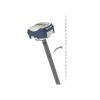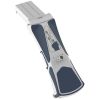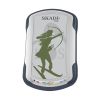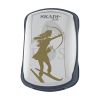Eos Skadi 300 RTK GNSS Receiver
Features
- Works with SBAS, RTK networks, and Atlas subscriptions
- Optional Skadi Tilt Compensation captures points quickly without having to level a survey range pole
- Compatible with Skadi Smart Handle for Invisible Range Pole and Extensible Virtual Range Pole features
- Free ground shipping
- Expedited repair and warranty service
- Lifetime technical support
- More
Overview
The Skadi 300 is an extremely robust RTK GNSS receiver in the Skadi Series from Eos Positioning Systems. With support for all GNSS constellations, triple-frequency, and most GNSS signals, the Skadi 300 lets you obtain a unique blend of accuracy and performance in the field. The Skadi 300 includes the popular SafeRTK feature for retaining your survey-grade accuracy when you temporarily lose internet connectivity to your source of RTK corrections. Additionally, you can use any RTK network, CORS network, base station, SBAS, and subscription Atlas correction services with the Skadi 300. It is also device agnostic to work with any iOS, Android, or Windows mobile device. In addition to the accuracy and performance features you would expect from an Eos GNSS receiver, the Skadi 300 includes additional advanced mapping capabilities available only in the Skadi Series product line. This includes Skadi Tilt Compensation so you can remain more productive at every point by not having to level your physical range pole. It also includes an integrated antenna and hot-swap, all-day battery to support any field mounting configuration (e.g., handheld setup, range pole, backpack).
Moreover, the Skadi 300 may be optionally upgraded to include the Skadi Smart Handle from the standard handle. Thanks to cutting-edge LiDAR and MEMS sensor, the Skadi Smart Handle offers a unique Invisible Range Pole feature to provide you with continuous elevation measurements to the ground. Meanwhile, a second feature of the Skadi Smart Handle, the Extensible Virtual Range Pole, lets you remotely capture short-distance assets on the ground and in trenches.
Skadi Tilt Compensation
When you activate Skadi Tilt Compensation, you eliminate the need to level your antenna while performing RTK data collection on a range pole. With Skadi Tilt Compensation activated, you introduce only .3 mm (.01 inch) of inaccuracy per degree of tilt.
Skadi Smart Handle
The Skadi Smart Handle is a physical upgrade to your included Skadi Standard Handle. The smart handle features two exciting and powerful features. These features include the following:
Invisible Range Pole
The Invisible Range Pole is an innovative approach to bringing the benefits of a traditional survey range pole into your hand without the cumbersome physical weight. With the Invisible Range Pole feature, you carry a virtual gimbal that keeps you plumb to the ground. Raise, lower, or tilt the receiver, your elevation to the ground is continuously computed below the Skadi receiver in your hand, thanks to the exciting combination of LiDAR and MEMS technologies.
Extensible Virtual Range Pole
This exciting and innovative feature allows you to extend the reach of your data collection beyond the position you physically occupy. Using a built-in green laser pointer, now you can “shoot” short-distance assets on the ground while retaining high accuracy. This is particularly useful for assets in trenches and similar environments. The Extensible Virtual Range Pole has an approximate range of about seven meters (23 feet) in bright sunlight conditions (performance may vary based on target reflectivity).
- Skadi 300 GNSS Receiver with Integrated Antenna
- Pole Mounting Plate for Skadi Series
- Skadi Standard Handle (upgradable to Skadi Smart Handle)
- Phone Mounting Bracket for Skadi Series Handles
- Tablet Mounting Bracket for Skadi Series Handles
- Skadi Series Li-Ion Battery Pack
- USB-C Power Block
- USB-C Cable
- Skadi Series Hardshell Case
In The News
Research in the Reserve: Promoting Interdisciplinary Conservation at the Great Bay National Estuarine Research Reserve
On an early winter day in 1973, a helicopter buzzed over Durham, New Hampshire, just a few miles from the Atlantic Ocean. One of the helicopter’s guests, oil magnate Aristotle Onassis, owner of Olympic Refining, looked east of town and saw what he hoped would become the world’s largest oil refinery. Instead, he saw the Great Bay; thousands of acres of green coastal forest, mud flats, salt marshes, and estuarine tidal waters stretching over the land toward New Hampshire's small Eastern coastline. Onassis likely also saw a group of Durham residents staked out on the bay’s coast, ready for him to pass overhead. While out of place in the natural setting, an obvious message was spelled out in red paper: “Not Here.
Read MoreFloating Global New Ideas: Buoy-Enabled Research at Florida Agricultural and Mechanical University’s School of the Environment
Florida Agricultural and Mechanical University (FAMU), based in Tallahassee, Florida, is the highest-rated public Historically Black College or University in the United States. FAMU’s School of the Environment (FAMU-SOE) offers BS and BA degrees in Environmental Studies, and BS, MS, and Ph.D. degrees in Environmental Science, with specialisms available in areas including Environmental Policy and Risk Management, Aquatic and Terrestrial Ecology, and Biomolecular Sciences. In 2021, FAMU-SOE deployed a NexSens CB-450 buoy in Apalachee Bay, a key oyster farming area around 30 miles south of Tallahassee. The buoy has quickly been incorporated into the curriculum, providing environmental insights for student research, the community, and beyond. Dr.
Read MoreMonitoring Habitat Suitability and Water Quality in Northwest Arkansas Springs
Northwest Arkansas has seen an economic, industrial, and population boom in recent years as a result of expanding businesses, which have created thousands of jobs in the region and the mass migration of employees and construction companies. However, with this growth has come rapid urbanization and the degradation of the natural landscape, specifically the freshwater springs that can be found throughout the region. These springs are critical habitat centers for native wildlife, home to threatened and endangered fish, and those that have yet to be listed. Zach Moran, Assistant Professor of Fisheries Science at Arkansas Technical University, is working to help monitor these habitats and provide key data that will hopefully inform future development in the region.
Read More

































